
Polychaeta is a paraphyletic class of generally marine annelid worms, commonly called bristle worms or polychaetes. Each body segment has a pair of fleshy protrusions called parapodia that bear many bristles, called chaetae, which are made of chitin. More than 10,000 species are described in this class. Common representatives include the lugworm and the sandworm or clam worm Alitta.
Order is one of the eight major hierarchical taxonomic ranks in Linnaean taxonomy. It is classified between family and class. In biological classification, the order is a taxonomic rank used in the classification of organisms and recognized by the nomenclature codes. An immediately higher rank, superorder, is sometimes added directly above order, with suborder directly beneath order. An order can also be defined as a group of related families.

Amniotes are a clade of tetrapod vertebrates that comprises sauropsids and synapsids. They are distinguished from the other tetrapod clade — the amphibians — by the development of three extraembryonic membranes, thicker and more keratinized skin, and costal respiration.

Coccidia (Coccidiasina) are a subclass of microscopic, spore-forming, single-celled obligate intracellular parasites belonging to the apicomplexan class Conoidasida. As obligate intracellular parasites, they must live and reproduce within an animal cell. Coccidian parasites infect the intestinal tracts of animals, and are the largest group of apicomplexan protozoa.

Subclass Rhabditia is mostly composed of parasitic nematodes, though there are some free-living species as well. Phasmids are well-developed, while amphids are poorly developed or absent in this group.
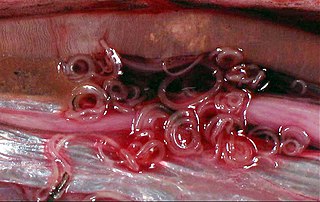
The order Ascaridida includes several families of parasitic roundworms with three "lips" on the anterior end. They were formerly placed in the subclass Rhabditia by some, but morphological and DNA sequence data rather unequivocally assign them to the Spiruria. The Oxyurida and Rhigonematida are occasionally placed in the Ascaridida as superfamily Oxyuroidea, but while they seem indeed to be Spiruria, they are not as close to Ascaris as such a treatment would place them. These "worms" contain a number of important parasites of humans and domestic animals.

The Batrachomorpha are a clade containing recent and extinct amphibians that are more closely related to modern amphibians than they are to mammals and reptiles. According to many analyses they include the extinct Temnospondyli; some show that they include the Lepospondyli instead. The name traditionally indicated a more limited group.

Secernentea was a class of nematodes in the Classical Phylogeny System and is no longer in use. This morphological-based classification system has been replaced by the Modern Phylogeny system, where taxonomy assignment is based on small subunit ribosomal DNA.
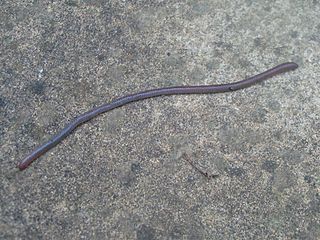
The Haplotaxida are one of two orders within the annelid subclass Oligochaeta, the other being the Lumbriculida. No real common name exists, but they are simply referred to as haplotaxids.
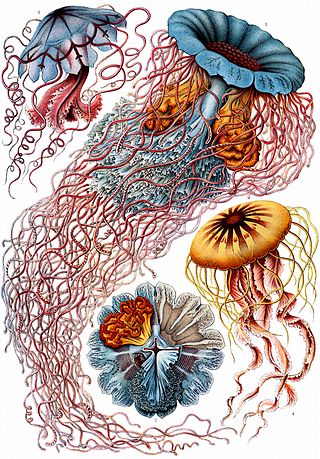
Discomedusae is a subclass of jellyfish in the class Scyphozoa. It is the sister taxon of Coronamedusae. Discomedusae contains about 155 named species and there are likely to be many more as yet undescribed. Jellyfish in this subclass are much more likely to have swarming events or form blooms than those in Coronamedusae. Discomedusae consists of two orders, Rhizostomae and Semaeostomeae.
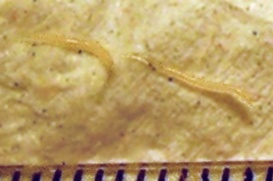
Oxyurida is an order of nematode worms of the class Secernentea. It consists of four families, one of which contains the human pinworm.

The phylogenetic classification of invertebrates remains a work-in-progress. The taxonomy of commonly fossilized invertebrates combines both traditional (old) and modern (21st-century) paleozoological terminology.

Diplogasterida was an order of nematodes. It was sometimes placed in a monotypic subclass Diplogasteria, but molecular phylogenetic evidence has shown it to be embedded in the family Rhabditidae. The confusion of having a hierarchical nesting of groups that were formerly mutually exclusive has led to a profusion of names. Although completely revised taxonomy of nematodes that builds on recent classification systems as well as recent phylogenetic evidence is still necessary, most contemporary taxonomic studies now treat all groups listed under "Diplogasterina" below as a single family, Diplogastridae.

In biology, taxonomic rank is the relative level of a group of organisms in an ancestral or hereditary hierarchy. A common system of biological classification (taxonomy) consists of species, genus, family, order, class, phylum, kingdom, domain. While older approaches to taxonomic classification were phenomenological, forming groups on the basis of similarities in appearance, organic structure and behaviour, methods based on genetic analysis have opened the road to cladistics.
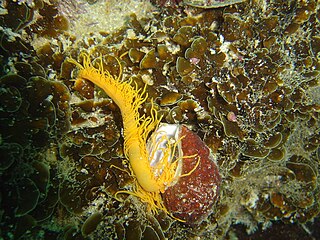
Terebellida make up an order of the Polychaeta class, commonly referred to as "bristle worms". Together with the Sabellida, the Spionida and some enigmatic families of unclear taxonomic relationship, they make up the subclass Canalipalpata, one of the three main clades of polychaetes. Like most polychaetes, almost all members of the Terebellida are marine organisms. Most are small, sessile detritivores which live in small tubes they build from mud or similar substrate, or burrow in the sand. Their central nervous system displays characteristic apomorphies.

The nematodes or roundworms constitute the phylum Nematoda, with plant-parasitic nematodes also known as eelworms. They are a diverse animal phylum inhabiting a broad range of environments. Less formally, they are categorized as helminths, but are taxonomically classified along with arthropods, tardigrades and other moulting animals in the clade Ecdysozoa, and unlike flatworms, have tubular digestive systems with openings at both ends. Like tardigrades, they have a reduced number of Hox genes, but their sister phylum Nematomorpha has kept the ancestral protostome Hox genotype, which shows that the reduction has occurred within the nematode phylum.
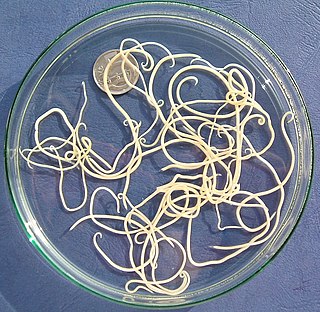
The suborder Ascaridina contains the bulk of the Ascaridida, parasitic roundworms with three "lips" on the anterior end. The Ascaridida were formerly placed in the subclass Rhabditia by some, but morphological and DNA sequence data rather unequivocally assigns them to the Spiruria. The Oxyurida and Rhigonematida are occasionally placed in the Ascaridina as superfamily Oxyuroidea, but while they seem indeed to be Spiruria, they are not as close to Ascaris as such a treatment would place them.

Phyllodocida is an order of polychaete worms in the subclass Aciculata. These worms are mostly marine, though some are found in brackish water. Most are active benthic creatures, moving over the surface or burrowing in sediments, or living in cracks and crevices in bedrock. A few construct tubes in which they live and some are pelagic, swimming through the water column. There are estimated to be more than 4,600 accepted species in the order.
The biological systematics and taxonomy of invertebrates as proposed by Richard C. Brusca and Gary J. Brusca in 2003 is a system of classification of invertebrates, as a way to classify animals without backbones.

















